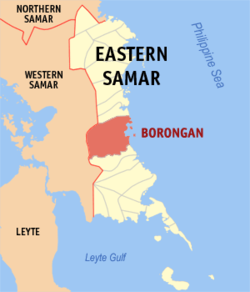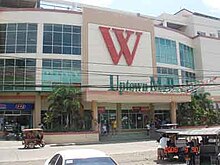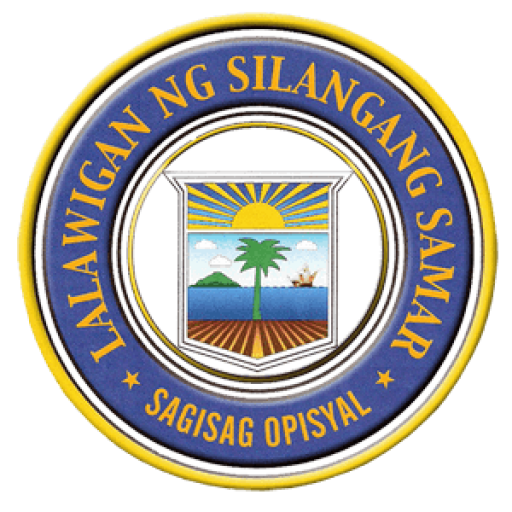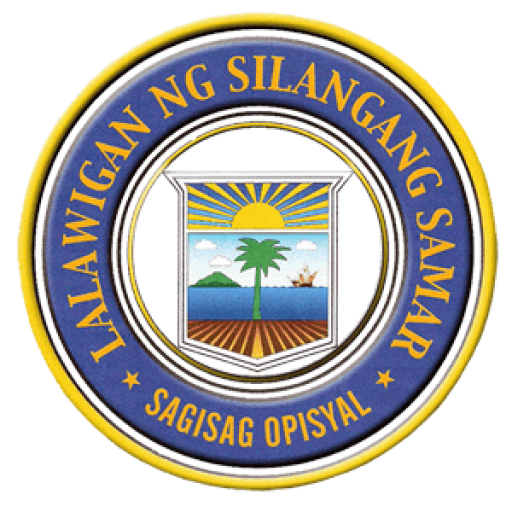Borongan
Borongan, pronounced bo-róng-gan, officially the City of Borongan (Waray: Siyudad han Borongan; Cebuano: Dakbayan sa Borongan; Filipino: Lungsod ng Borongan), is a component city and the provincial capital of the province of Eastern Samar, Philippines, and known to be as the easternmost city in the Philippines, Its cityhood was settled by the Supreme Court of the Philippines when it decided with finality on April 12, 2007, the constitutionality of its city charter, Republic Act 9394, which conferred upon and elevated the status of the municipality of Borongan into a component city of the province of Eastern Samar.
Geography
The city is bounded on the north by the municipality of San Julian, in the south by the municipality of Maydolong, in the west by the Samar municipalities of Hinabangan, Calbiga, Pinabacdao and Basey, and in the east by the Pacific Ocean.
Barangays
Alang-alang, Amantacop, Ando, Balacdas, Balud, Banuyo, Baras, Bato, Bayobay, Benowangan, Bugas, Cabalagnan, Cabong, Cagbonga, Calico-an, Calingatngan, Campesao, can-abong, Can-aga, Camada, Canjaway, Canlaray, Canyopay, Divinubo, Hebacong, Hindang, Lalawigan, Libuton, Locsoon, Maybacong, Maypangdan, Pepelitan, Pinanag-an, Purok A (Poblacion), Purok B (Pob.), Purok C Pob.), Purok D1 (Pob.), Purok D2 (Pob.), Purok E (Pob.), Purok F (Pob.), Purok G Pob.), Purok H (Pob.), Punta Maria, Sabang North, Sabang South, San Andres, San Gabriel, San Gregorio, San Jose, San Mateo, San Pablo, San Saturnino, Santa Fe, Siha, Songco, Sohutan, Suribao, Surok, Taboc, Tabunan, Tamoso


History
As early as 1595, or 74 years after Ferdinand Magellan’s landing in Homonhon (now an island barangay of Guiuan, Eastern Samar) Spanish Jesuit missionary priests from mission centers in Leyte began to evangelize the southern portion of the island of Samar. The first evangelical mission was established in Tinago, Western Samar and gradually expanded to Catubig. In 1614 Palapag was selected as the mission center of the Ibabao region or the north-eastern coast of the island; from this mission center in turn was the eastern coast of Samar subsequently evangelized. The missionaries proselytized to the inhabitants in the faith, raised stone churches, and protected the people from the Muslim predatory/piratical raids from the south. This is probably the reason why the town itself was established some distance away from the shoreline and built on a hill overlooking the northern banks of the Lo-om River. In fact, the old Catholic church convent has its own self-contained water supply: a deep dugout well lined with big blocks of ancient hewn stones located underneath the convent building itself. The major settlements then were Borongan, Bacod/Jubasan/Paric (now Dolores), Tubig (Taft), Sulat, Libas/Nonoc (now San Julian), Butag (now Guiuan) and Balangiga.
The development of Borongan was greatly influenced by the religious missions of the Jesuits during the period 1604–1768, and the Franciscans from 1768 to 1868. Borongan was established as a pueblo on September 8, 1619. On this date, the Commandancia and the Very Reverend Father Superior of the Jesuits from Palapag, a town of Northern Samar, went to Ibabao to install the first priest of Borongan, Fr. Manuel Martinez, who served up to 1627.
At the outbreak of the Philippine Revolution in 1898, Borongan was the site of an uprising led by the Pulahanes. The first public municipal officials were Sr. Magno Abenis, President, and Sr. Andres Hipe, Vice-President, who held office from 1899 to 1903. After the Japanese occupation in 1941-1945, the town was henceforth led by a mayor and a vice mayor. Hilarion Basada and Ignacio Brozas were the first mayor and vice mayor, respectively, from 1945 to 1947.
Borongan was legally constituted as a capital town when Eastern Samar was created as a separate province under Republic Act No. 4221 which was enacted on June 19, 1965.[6] Its first municipal mayor as the capital town of Eastern Samar was Luis Capito.
On June 21, 2007, Borongan became the first city in Eastern Samar. However, it subsequently lost its cityhood, along with 15 other cities, after the Supreme Court of the Philippines granted a petition filed by the League of Cities of the Philippines, and declared the cityhood law (RA 9394) which granted the town its city status, unconstitutional. The said 16 cities, the court ruled, did not meet the requirements for cityhood.
Cityhood
During the 12th Congress (2001–2004), Congress enacted into law Republic Act No. 9009 (RA 9009), which took effect on 30 June 2001. RA 9009 amended Section 450 of the Local Government Code by increasing the annual income requirement for conversion of a municipality into a city from ₱20 million to ₱100 million. The rationale for the amendment was to restrain, in the words of Senator Aquilino Pimentel, “the mad rush” of municipalities to convert into cities solely to secure a larger share in the Internal Revenue Allotment despite the fact that they are incapable of fiscal independence.
After RA 9009 went into effect, the House of Representatives of the 12th Congress adopted Joint Resolution No. 29, which sought to exempt from the ₱100 million income requirement in RA 9009 the 24 municipalities whose cityhood bills were not approved in the 11th Congress. However, the 12th Congress ended without the Senate having approved Joint Resolution No. 29.
During the 13th Congress (2004–2007), the House of Representatives re-adopted former Joint Resolution No. 29 as Joint Resolution No. 1 and forwarded it to the Senate for approval. However, the Senate again failed to approve the Joint Resolution. Following the suggestion of Senator Aquilino Pimentel (Senate President), 16 municipalities filed, through their respective sponsors, individual cityhood bills. The 16 cityhood bills each contained a common provision exempting it from the ₱100 million income requirement of RA 9009 –
“Exemption from Republic Act No. 9009. — The City of x x x shall be exempted from the income requirement prescribed under Republic Act No. 9009.”
On 22 December 2006, the House of Representatives approved the cityhood bills. The Senate also approved the cityhood bills in February 2007, except that of Naga, Cebu which was passed on 7 June 2007. These cityhood bills lapsed into law on various dates from March to July 2007 after President Gloria Macapagal-Arroyo failed to sign them.
The point of law at issue in 2007 was whether there had been a breach of Section 10, Article X of the 1987 Constitution, which provides –
No province, city, municipality, or barangay shall be created, divided, merged, abolished or its boundary substantially altered, except in accordance with the criteria established in the local government code and subject to approval by a majority of the votes cast in a plebiscite in the political units directly affected.
– and in each case the established criteria were far from met.
In November 2008, Borongan and 15 other cities lost their cityhood after the Supreme Court of the Philippines granted a petition filed by the League of Cities of the Philippines, and declared unconstitutional the cityhood law (RA 9394) which had allowed the town to acquire its city status.The Supreme Court ruled that they did not pass the requirements for cityhood.
On 10 December 2008, the 16 cities affected acting together filed a motion for reconsideration with the Supreme Court. More than a year later, on 22 December 2009, acting on said appeal, the Court reversed its earlier ruling as it ruled that “at the end of the day, the passage of the amendatory law” (regarding the criteria for cityhood as set by Congress) “is no different from the enactment of a law, i.e., the cityhood laws specifically exempting a particular political subdivision from the criteria earlier mentioned. Congress, in enacting the exempting law/s, effectively decreased the already codified indicators.”[11] Accordingly cityhood status was restored.
But on 27 August 2010, the 16 cities lost their city status again, after the Supreme Court voted 7-6, with two justices not taking part, to reinstate the 2008 decision declaring as “unconstitutional” the Republic Acts that converted the 16 municipalities into cities. A previous law required towns aspiring to become cities to earn at least ₱100 million annually, which none of the 16 did.
On 15 February 2011, the Supreme Court made another volte-face and upheld for the third time the cityhood of 16 towns in the Philippines.
Finally, on 12 April 2011, the Supreme Court, in an en banc ruling delivered in Baguio City, affirmed the finality of the constitutionality of the 16 cityhood laws by resolving that:
We should not ever lose sight of the fact that the 16 cities covered by the Cityhood Laws not only had conversion bills pending during the 11th Congress, but have also complied with the requirements of the LGC prescribed prior to its amendment by R.A. No. 9009.[12] Congress undeniably gave these cities all the considerations that justice and fair play demanded. Hence, this Court should do no less by stamping its imprimatur to the clear and unmistakable legislative intent and by duly recognizing the certain collective wisdom of Congress. WHEREFORE, the Ad Cautelam Motion for Reconsideration (of the Decision dated 15 February 2011) is denied with finality.
On 28 June 2011 the Supreme Court directed the Clerk of Court to issue the entry of judgment on the cityhood case of 16 municipalities.
Demographics
The local dialect is Waray-Waray, locals are also literate in both English and Filipino. Boronganons are predominantly Roman Catholic, but it also has other small Christian as well as minority religious sects.
Livelihood
Commercial Activity

Wilsam Uptown Mall, the only shopping mall in Eastern Samar
Surfing & Skimboarding
Below are some of the surfing spots in Borongan:
BOULEVARD (BORONGAN BAY) – Known as the birthplace of surfing in the Visayas, this is the nearest surf spot from Borongan town proper. This surf spot has a sandy bottom, right hand rivermouth beach break. Perfect for both beginners and advance surfers.
PIRATES COVE BEACH & SURF RESORT – A 5-minute drive from Borongan town proper brings you to this 2-hectare private reef, marine sanctuary and water sports recreation area. This is an exposed reef break facing the Pacific Ocean filled with rocks and corals.
SULANGAN BEACH – A left and right hand steady beach break that is ideal for beginners. A good place to learn how to surf.
LALAWIGAN – Still part of Borongan, this barangay is rarely visited. Only advanced surfers frequent the area due to its rough waves and strong current.
GUINTAGICAN BEACH – A beautiful 2 km beach with white sand. It has a left and right hand beach break with inconsistent surf. During the summer season, it tends to be flat. Also ideal for beginners.
Beaches
Islands and Island Beaches
- Ando Island white sand beach
- Butay island (located at the middle of Lo-om River between the upstream concrete bridge connecting the city proper to and from Brgy. Taboc and the downstream steel-and-concrete bridge connecting the city proper to and from Brgy. Alang-alang)
- Divinubo Island white sand beach
- Monbon Island white sand beach (the sparse island vegetation is supposedly infested with small blood-sucking red ticks – locally called “tungaw” – which however are easily killed off by immersion in seawater)
- Pamuloton Island beach (Tabunan)
Rivers
- Balacdas River
- Borongan or Sabang (formerly called Guiborongani) River
- Can-obing River
- Lo-om River
- Maypangdan River
- Naghahagong underground river located past sitio Cati-an (its “snore” or “hagong” – hence the name – can be heard by the locals when there is heavy rains as the onrushing torrent of water gushes and rumbles underground), ideal for spelunkers although it has remained unexplored up to this day and thus relatively unknown to outsiders
- Palanas River
- Salog River in Brgy. Cancaligdas
- Suribao River (serves as common city/municipal boundary with the adjacent town of Maydolong)
City Park
From underneath this giant clamshell bubbles and flows the Hamorawon natural spring, the only one place in the entire province of Eastern Samar which has a naturally occurring fresh-water spring, flowing from the very center of the city itself towards the Lo-om River a short distance downstream. The waters of this spring has been said to be miraculous the site itself having allegedly been the place where appearances of a lady in white (supposed to be the patroness saint of the city) have reportedly been seen. Unfortunately, access to this natural water source has of late been impeded and virtually blocked, its previous access road having been long fenced off leaving the spring almost unnoticeable already to busy passersby.
Local Government
The city government of Borongan has its own executive, legislative and judicial branches:
Executive
The seat of the executive branch of the local government of Borongan is at the city hall located at the city proper itself with the city mayor acting as the local chief executive.
Legislative
The legislative department is represented by the local Sangguniang Panglungsod composed of ten (10) elected members headed by the city vice mayor as the presiding officer thereof.
Judicial
- Regional Trial Court, Branches I & II – both located at the Hall of Justice Bldg., Provincial Capitol Complex in Brgy. Alang-alang.
- Municipal Trial Court – also located at the Hall of Justice Bldg., Provincial Capitol Complex in Brgy. Alang-alang.
Constitutional Bodies
- Commission on Audit
- Commission on Elections
- Civil Service Commission
Peace and Order
Transportation
Sea
Land
Air
Communications
Electric Power
Education
Elementary Schools
Secondary Schools
Benowangan National High School, Calingatngan National High School, Eastern Visayas International Montessori School, Eastern Samar National Comprehensive High School, Lalawigan National High School, Maypangdan National High School, Saint Mary’s College (formerly Saint Joseph’s College), High School Department, Seminario de Jesus Nazareno (exclusive high school for boys), MSH Sisters High School, Fe National High School, Fidel E. Anacta Sr. Memorial High School
Colleges
University
Notable Boronganons Artist
Entertainment
Boy Abunda – television host, publicist, talent manager and celebrity endorser. He is dubbed as the “King of Talk” in local show business. He is originally from Brgy. Campesao.
Photography
Aaron Ebio – portrait and fashion photographer. Hailed as one of the top 15 wedding photographers in the Philippines. Shoots for various media and modeling agencies.
Fashion
Ino Amoyo – professional hair stylist. Represented the Philippines and among the top finalists of the 2014 Worldwide Hair Tour competition in London.
Athletes
Jewel Ponferada – PBA professional basketball player. Currently playing for Rain or Shine Elasto Painters.
Local Officials
Mayor: Maria Fe R. Abunda
Vice Mayor: Fidel V. Anacta, Jr.
SB Members
2. Renato C. Bagacay
3. Emmanuel T. Tiu Sonco
4. Napoileon A. Bebita
5. Aurora A. Anasarias
6. Estanislao N. Quelitano, Jr.
7. Marlyn V. Sy
8. Glenn A. Escoto
9. Leonaldo A. Ador, Jr.
10. Jennifer S. Anacio
References
- “Municipalities”. Quezon City, Philippines: Department of the Interior and Local Government. Archived from the original on 25 January 2013. Retrieved 24 April 2013.
- “Province: Eastern Samar”. PSGC Interactive. Makati City, Philippines: National Statistical Coordination Board. Archived from the original on November 14, 2012. Retrieved 24 April 2013.
- Census of Population (2015). “Region VIII (Eastern Visayas)”. Total Population by Province, City, Municipality and Barangay. PSA. Retrieved 20 June 2016.
- “Archived copy”. Archived from the original on 2011-06-25. Retrieved 2011-04-13.
- “Weatherbase: Weather for Borongan, Philippines”. Weatherbase. 2011. Retrieved on November 22, 2011.
- “R.A. No. 4221, An Act Creating the Provinces of Northern Samar, Eastern Samar and Western Samar”. LawPH.com. Retrieved 2011-04-27.
- Supreme Court of the Philippines Archived 2009-03-19 at the Wayback Machine.
- Republic Act No. 9394 of 16 March 2007 Charter of the City of Borongan
- R. No. 176951 et al. (First appeal) of 18 November 2008 Consolidated petitions for prohibition assailing the constitutionality of the subject Cityhood Laws and enjoining the Commission on Elections (COMELEC) and respondent municipalities from conducting plebiscites pursuant to the Cityhood Laws.
- Napallacan, Jhunex (2008-11-21). “Cities’ demotion worries DepEd execs”. Cebu Daily News. Inquirer.net. Retrieved 15 February 2015.
- R. No. 176951 et al. (First reversal) of 21 December 2009
- Republic Act No. 9009 of 24 February 2001 An Act amending section 450 of Republic Act no. 7160, otherwise known as the Local Government Code of 1991, by increasing the average annual income requirement for a municipality or cluster of barangays to be converted into a component city.
- R. No. 176951 et al. (Second appeal) of 15 February 2011 League of Cities of the Philippines v. COMELEC
- R. No. 176951 et al. (Final Resolution) of 28 June 2011 Supreme Court has directed the Clerk of Court to forthwith issue the Entry of Judgment
- Census of Population and Housing (2010). “Region VIII (Eastern Visayas)”. Total Population by Province, City, Municipality and Barangay. NSO. Retrieved 29 June 2016.
- Census of Population (1995, 2000 and 2007). “Region VIII (Eastern Visayas)”. Total Population by Province, City and Municipality. NSO. Archived from the original on 24 June 2011.
- “Province of Eastern Samar”. Municipality Population Data. Local Water Utilities Administration Research Division. Retrieved 17 December 2016.
- National Statistics Office Archived July 16, 2012, at the Wayback Machine.
- “Total Population by Province, City, Municipality and Barangay: as of May 1, 2010” (PDF). 2010 Census of Population and Housing. National Statistics Office. Archived from the original (PDF) on 20 March 2013. Retrieved 22 April 2013.


